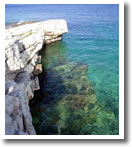
Paxos Beaches
There are approximately thirty beaches on Paxos, the majority of which are located on the east coast of the island. Most beaches are either stone or shale, though there are a couple of sandy beaches to be found; one in Lakka, the other in Mongonisi. The water around Paxos is extremely clear, clean and warm, with a fantastic turquoise hue.
All beaches are considered safe for swimming, though none of the beaches have life guards on duty. The exposed west coast of Paxos is much more rugged, and does not have any beaches that are accessible from land. The west coast does, however, have a series of caves called the Blue Caves that are simply spectacular and it is well worth a boat trip to see these. Below is a summary of the beaches that can be found on Paxos and Anti-Paxos.

If you travel around Paxos by boat, you will discover many places to stop and enjoy the coastline.
Although much of the Paxos coastline is rocky, it is possible to find flat enough areas from which you can sunbathe or go swimming off the rocks.
To see more photos and videos of Paxos and Anti-Paxos, visit the Gallery.
Gaios Beaches
North of Gaios, there is a sheltered beach called Kaki Langada. This beach is comprised mainly of pebbles. During the main holiday season there is a small 'Kantina' open serving snacks and cool drinks. There are also several coves to be found south of Gaios, towards Mongonisi.
Lakka Beaches
There are two beaches in the bay at Lakka: Harami and Kanoni. Of these, Harami is the sandiest beach and is popular with young families. Around Planos headland to the north, a few more beaches can be found: Planos and Achai. Heading south from Lakka, towards Loggos, there are two more beaches: Monodendri and Glyfada. Monodendri, which means single tree, is the most popular of these two beaches, as it is nearest to Lakka and is the most accessible. Glyfada is closer to Loggos, but can only be accessed via a steep and rough footpath or from the sea via boat. As such, Glyfada beach is much quieter than Monodendri.
Loggos Beaches
The beach of Levrecchio is roughly a five minute walk south of Loggos. This beach can become very busy during the peak holiday season due to its ease of access. There is a taverna nearby from which you can buy meals and cool drinks.
Also near Loggos, further south than Levrecchio, are the beaches of Kipos and Marami. These two beaches are only accessible by foot or by boat and so are quieter than Levrecchio. There is some welcome shade to be found on these beaches, as the olive groves grow right down to the edge of the beach.
A popular beach with yachts and motor cruisers is Kipiadi. This beach can be reached from the track that also leads to the beach of Pounda, though the track is steep in places. Both of these beaches are further south from Loggos, roughly half way to Gaios.
Mongonisi Beaches
There is a single, man made beach at Mongonisi. This is the sandiest beach on the island and is popular with young families. Mongonisi is also a popular mooring point for yachts and motor cruisers. It benefits from a taverna at the back of the beach. There are water sports available at the beach in Mongonisi, including windsurfing and peddlos.
Anti-Paxos Beaches
There are several beaches on Anti-Paxos, with the most popular two being Vrika and Voutoumi. Both of these beaches are sandy (Voutoumi is only sandy underfoot once in the water) and both have beach bars open during the main holiday season. Both of these beaches can also be busy during the peak holiday period and are usually frequented by yachts and motor cruisers. Other, more secluded beaches and coves can be accessed on Anti-Paxos by boat. There are numerous organised trips to Anti-Paxos available from the three main villages of Gaios, Lakka and Loggos.
Paxos West Coast Cliffs
The west coast of Paxos is famous for the sheer cliffs and spectacular scenery. The Blue Caves make for an exciting and memorable boat trip, though most small self-sail hire boats are prohibited from visiting these waters. There are, however, many organised boat trips to this side of the island. The largest cave is at Grammatiko, whilst the cave at Kastanitha is a spectacular sight at 600 feet high.
There are several small coves that are only accessible by boat on the west coast of Paxos, all of which are quiet, even in the peak season.
Whilst you cannot access the west coast shoreline of Paxos from land, you can explore the footpaths that run along the top of the cliffs. These pathways offer stunning views along the rugged coastline of Paxos, particularly late in the afternoon and at sunset.